The Brain
Understanding the Science of Learning. Twitter. Twitter. How The Memory Works In Learning. How The Memory Works In Learning contributed by Dr.
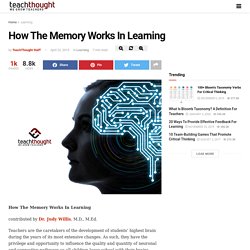
Judy Willis, M.D., M.Ed.
Youtube. How The Memory Works In Learning. 500 Internal Server Error. A recent interview with British neuroscientist Sarah-Jayne Blakemore, the author of the 2018 book Inventing Ourselves: The Secret Life of the Teenage Brain, begins with a caveat. “I think it’s important to know before we start that up until 20 years ago we really didn’t know that the brain changes at all after childhood,” she confides. “That’s what I was taught during my undergraduate degree. We now know that’s completely untrue.” In matters of settled opinion, science has often found itself in the role of provocateur, even saboteur—prodding at conventional wisdoms until they yield unexpected truths, and sometimes toppling them entirely.
The mysteries of celestial bodies, heredity, and mental illness have all undergone dramatic rethinking. So it shouldn’t be entirely surprising that new technologies that allow us to peer into the brain as it processes information are driving a revolution in our understanding of human cognition.
500 Internal Server Error. Teaching students basic knowledge about the brain’s potential can have a positive impact on their motivation, grit, and achievement. In particular, explicitly teaching them that learning changes the structure and function of their brains can be transformational in building a stronger belief in the value of working hard to master new material. Teachers who explain these findings report that the knowledge has a positive effect on students’ perceptions of their abilities as well as on their expectations for success.
Examples From Elementary Classrooms Diane Dahl of Texas, a participant in our brain-based teaching program, enjoys teaching her elementary students about the brain and strategies for learning. Students learn what neurons, dendrites, and axons are and how connections between neurons created by axons and dendrites create learning.
Why Students Forget—and What You Can Do About It. Teachers have long known that rote memorization can lead to a superficial grasp of material that is quickly forgotten. But new research in the field of neuroscience is starting to shed light on the ways that brains are wired to forget—highlighting the importance of strategies to retain knowledge and make learning stick. In a recent article published in the journal Neuron, neurobiologists Blake Richards and Paul Frankland challenge the predominant view of memory, which holds that forgetting is a process of loss—the gradual washing away of critical information despite our best efforts to retain it.
According to Richards and Frankland, the goal of memory is not just to store information accurately but to “optimize decision-making” in chaotic, quickly changing environments.
Bringing the Science of Learning Into Classrooms. New research sheds light on the effects that childhood experiences—both good and bad—have on the developing brain. But are schools keeping up? “The 20th-century education system was never designed with the knowledge of the developing brain,” says Pamela Cantor, MD, who is part of a cross-disciplinary team of experts studying the science of learning and development.
“So when we think about the fact that learning is a brain function and we have an education system that didn’t have access to this critical knowledge, the question becomes: Do we have the will to create an education system that’s informed by it?” Contrary to the long-held belief that brain maturation is largely complete by the age of 6, we now know that our brains are malleable and continue to change dramatically well into our 20s. This has profound implications for learning throughout the school-age years.
The Tyranny of Being On Task. I remember when I was first teaching and was getting ready for my first official observation and evaluation.

I was very nervous. My principal had told me she would be looking for a classroom where students were on task. Heaven forbid that any students were off task.
What Neuroscience Can Tell Us About Making Fractions Stick. Public Media for Northern CA. Oakley recognizes that “many educators are not at all comfortable with or trained in neuroscience,” so she breaks down a few key principles that teachers can use in the classroom and share with students to help them demystify the learning process. 1.
The Hiker Brain vs. The Race Car Brain Start by teaching students the difference between focused and diffused thinking, says Oakley. When the brain is in focused mode, you can get started on the task at hand. Diffused thinking occurs when you allow your mind to wander, to imagine and to daydream.
The Chan Zuckerberg Initiative Wants Teachers to Learn Brain Science - Teaching Now. One of the most recognizable couples of Silicon Valley is on a new education-related mission: to help teachers learn about how students' brains work.

The Chan Zuckerberg Initiative, the philanthropic organization led by Facebook CEO Mark Zuckerberg and his wife, pediatrician Priscilla Chan, is donating $1 million to support the development of teacher professional-learning in educational neuroscience. The sum will contribute to the expansion of Neuroteach Global, an online PD platform created by the Center for Transformative Teaching and Learning, a mind, brain, and education research center based out of St. Andrew's Episcopal School in Potomac, Md.
Is This The Most Important Thing A Teacher Should Know?
What's Going on Inside the Brain Of A Curious Child?
By Maanvi Singh, NPR How does a sunset work?
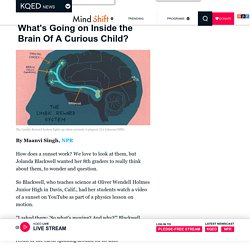
We love to look at them, but Jolanda Blackwell wanted her 8th graders to really think about them, to wonder and question.
How Stress Changes A Student's Brain: The Neurology Of 'Pressure' -
Resources on Learning and the Brain. 5 ways teachers can improve student learning based on current brain research. The brain is an experience-dependent organ.
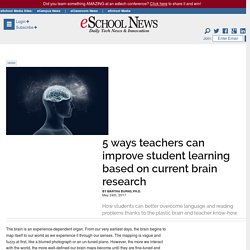
Retrieval Practice: A Teachers' Definition and Video Examples. Retrieval Practice: Image via Oliver Caviglioli We’ve been reading up a lot on retrieval practice lately.
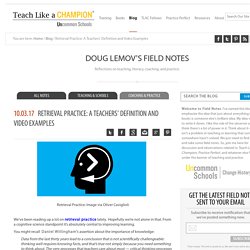
Hopefully we’re not alone in that. From a cognitive science standpoint it’s absolutely central to improving learning. You might recall Daniel Willingham’s assertion about the importance of knowledge: Data from the last thirty years lead to a conclusion that is not scientifically challengeable: thinking well requires knowing facts, and that’s true not simply because you need something to think about.
Why Students Forget—and What You Can Do About It. Using Brain Breaks to Restore Students’ Focus. Early in my teaching career, I was disturbed by a note left by the substitute teacher.
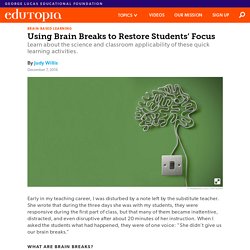
She wrote that during the three days she was with my students, they were responsive during the first part of class, but that many of them became inattentive, distracted, and even disruptive after about 20 minutes of her instruction. When I asked the students what had happened, they were of one voice: “She didn’t give us our brain breaks.”
Neuralink and the Brain's Magical Future - Wait But Why. Note: If you want to print this post or read it offline, the PDF is probably the way to go. You can buy it here.And here’s a G-rated version of the post, appropriate for all ages. Last month, I got a phone call. Okay maybe that’s not exactly how it happened, and maybe those weren’t his exact words.
What’s Going on Inside the Brain Of A Curious Child?
By Maanvi Singh, NPR How does a sunset work?

We love to look at them, but Jolanda Blackwell wanted her 8th graders to really think about them, to wonder and question. So Blackwell, who teaches science at Oliver Wendell Holmes Junior High in Davis, Calif., had her students watch a video of a sunset on YouTube as part of a physics lesson on motion.
Why Brain-Based Learning Means Always Connecting Old Knowledge With New. Why Brain-Based Learning Means Always Connecting Old Knowledge With New by Judy Willis M.D., M.Ed., radteach.com Building and retrieving memories takes place in stages through information encoding, storage in patterns of relational memories, and restimulating these neuronal pathways by review each time the memory is accessed and used.
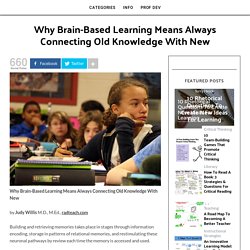
Familiarity increases recall so students with memory-based learning difficulties can preview the coming lesson by skimming the new section in the book before class.
Put Working Memory to Work in Learning. Editor's Note: This post is co-authored by Marcus Conyers who, with Donna Wilson, is co-developer of the M.S. and Ed.S.
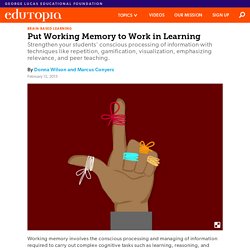
Brain-Based Teaching degree programs at Nova Southeastern University. Working memory involves the conscious processing and managing of information required to carry out complex cognitive tasks such as learning, reasoning, and comprehension. It has been described as the brain's conductor. Memory has long been viewed as a key aspect of learning, but as the emphasis in educational standards has shifted away from rote memorization and toward the knowledge and skills needed to process new information, working memory is increasingly taking center stage.
The Science of Gratitude - How it Changes People, Relationships (and Brains!) and How to Make it Work For You. Bilingual Education: 6 Potential Brain Benefits : NPR Ed. Part of our ongoing series exploring how the U.S. can educate the nearly 5 million students who are learning English. Brains, brains, brains.
Resources on Learning and the Brain.










